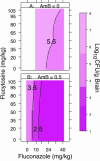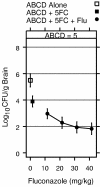Amphotericin B and fluconazole, a potent combination therapy for cryptococcal meningitis
- PMID: 14982793
- PMCID: PMC353060
- DOI: 10.1128/AAC.48.3.985-991.2004
Amphotericin B and fluconazole, a potent combination therapy for cryptococcal meningitis
Abstract
We evaluated the antifungal activities of amphotericin B, fluconazole, and flucytosine, alone and in combination, in a murine model of cryptococcal meningitis. The objectives were to determine the greatest antifungal effects achievable with these drugs alone or in combination. Meningitis was established in male BALB/c mice weighing 23 to 25 g by intracerebral injection of Cryptococcus neoformans. Treatment was started on day 2. Amphotericin B was tested at 0.3 to 1.3 mg/kg of body weight/day by slow intravenous injection. Fluconazole at 10 to 40 mg/kg/day and flucytosine at 20 to 105 mg/kg/day were administered in the sole source of drinking water. The mice were killed at 16 days, and the numbers of fungal colonies in the brain were quantified. The association between the response and the dose combination was evaluated by local nonparametric response surface methods; 99% confidence intervals were used to evaluate the antifungal effects. Ninety-five percent of the mice treated with amphotericin B at 0.5 mg/kg survived to the end of the experiment, regardless of the fluconazole or flucytosine dose used. The greatest activity was seen with amphotericin B plus fluconazole with or without flucytosine. However, the addition of flucytosine did not increase the antifungal activity. Given the widespread availability of amphotericin B and fluconazole and the relative safety profile of fluconazole compared to that of flucytosine, the full potential of this two-drug combination deserves further evaluation.
Figures







Similar articles
-
Amphotericin B colloidal dispersion combined with flucytosine with or without fluconazole for treatment of murine cryptococcal meningitis.Antimicrob Agents Chemother. 1998 Mar;42(3):528-33. doi: 10.1128/AAC.42.3.528. Antimicrob Agents Chemother. 1998. PMID: 9517927 Free PMC article.
-
Effect of fluconazole on fungicidal activity of flucytosine in murine cryptococcal meningitis.Antimicrob Agents Chemother. 1996 Sep;40(9):2178-82. doi: 10.1128/AAC.40.9.2178. Antimicrob Agents Chemother. 1996. PMID: 8878602 Free PMC article.
-
Effects of fluconazole singly and in combination with 5-fluorocytosine or amphotericin B in the treatment of cryptococcal meningoencephalitis in an intracranial murine model.J Chemother. 2002 Aug;14(4):351-60. doi: 10.1179/joc.2002.14.4.351. J Chemother. 2002. PMID: 12420852
-
Leave no one behind: response to new evidence and guidelines for the management of cryptococcal meningitis in low-income and middle-income countries.Lancet Infect Dis. 2019 Apr;19(4):e143-e147. doi: 10.1016/S1473-3099(18)30493-6. Epub 2018 Oct 18. Lancet Infect Dis. 2019. PMID: 30344084 Review.
-
[The efficacy of sequential treatment with amphotericin B-fluorocytosine and fluconazole in cryptococcal meningitis not associated with AIDS].Rev Clin Esp. 1999 Jul;199(7):480. Rev Clin Esp. 1999. PMID: 10481571 Review. Spanish. No abstract available.
Cited by
-
In vitro-clinical correlations for amphotericin B susceptibility in AIDS-associated cryptococcal meningitis.Antimicrob Agents Chemother. 2007 Jan;51(1):343-5. doi: 10.1128/AAC.00742-06. Epub 2006 Oct 23. Antimicrob Agents Chemother. 2007. PMID: 17060519 Free PMC article.
-
A clinical, aetiological, and public health perspective on central nervous system infections in Bolivia, 2017-2018.Sci Rep. 2021 Dec 1;11(1):23235. doi: 10.1038/s41598-021-02592-6. Sci Rep. 2021. PMID: 34853372 Free PMC article.
-
Factors associated with early mycological clearance in HIV-associated cryptococcal meningitis.PLoS One. 2017 Mar 29;12(3):e0174459. doi: 10.1371/journal.pone.0174459. eCollection 2017. PLoS One. 2017. PMID: 28355252 Free PMC article.
-
Methodologies for in vitro and in vivo evaluation of efficacy of antifungal and antibiofilm agents and surface coatings against fungal biofilms.Microb Cell. 2018 Jun 14;5(7):300-326. doi: 10.15698/mic2018.07.638. Microb Cell. 2018. PMID: 29992128 Free PMC article. Review.
-
Correlation of the in vitro antifungal drug susceptibility with the in vivo activity of fluconazole in a murine model of cerebral infection caused by Cryptococcus gattii.Eur J Clin Microbiol Infect Dis. 2010 Dec;29(12):1525-32. doi: 10.1007/s10096-010-1034-8. Epub 2010 Aug 28. Eur J Clin Microbiol Infect Dis. 2010. PMID: 20803047
References
-
- Alves, S. H., J. O. Lopes, J. M. Costa, and C. Klock. 1997. Development of secondary resistance to fluconazole in Cryptococcus neoformans isolated from a patient with AIDS. Rev. Inst. Med. Trop. Sao Paulo 39:359-361. - PubMed
-
- Armengou, A. C., Porcar, J. Mascaro, and F. Garcia-Bragado. 1996. Possible development of resistance to fluconazole during suppressive therapy for AIDS-associated cryptococcal meningitis. Clin. Infect. Dis. 23:1337-1338. - PubMed
-
- Bauer, M., A. M. Thomas, J. R. Graybill, and R. A. Larsen. 1998. Display of confidence intervals for response surfaces in combination drug experiments, p. 100-105. In Proceedings of statistical graphics, 1997 JSM. American Statistical Association, Alexandria, Va.
-
- Bennett, J. E., W. E. Dismukes, R. J. Duma, G. Medoff, M. A. Sande, H. Gallis, J. L. Leonard, B. T. Fields, M. Bradshaw, H. Haywood, Z. A. McGee, T. R. Cate, C. G. Cobbs, J. F. Warner, and D. W. Alling. 1979. A comparison of amphotericin B alone and combined with flucytosine in the treatment of cryptococcal meningitis. N. Engl. J. Med. 301:126-131. - PubMed
-
- Birley, H. D., E. M. Johnson, P. McDonald, C. Parry, P. B. Carey, and D. W. Warnock. 1995. Azole drug resistance as a cause of clinical relapse in AIDS patients with cryptococcal meningitis. Int. J. STD AIDS 6:353-355. - PubMed
Publication types
MeSH terms
Substances
Grants and funding
LinkOut - more resources
Full Text Sources
Other Literature Sources

